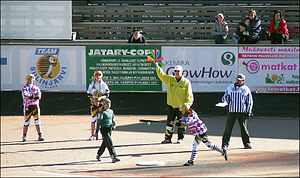Pesäpallo

Girls playing pesäpallo in Siilinjärvi in 2006.
|
|
| First played | 1920s |
|---|---|
| Characteristics | |
| Team members | 9 (on defense) 12 (on offense) |
| Type | Bat-and-ball |
| Equipment | Ball, bat, gloves, helmet, pitching plate |
| Presence | |
| Olympic | Demonstrated 1952 |
Pesäpallo (Finnish pronunciation: [pesæpɑlːo]; Swedish: boboll, both names literally meaning "nest ball", also referred to as "Finnish baseball") is a fast-moving bat-and-ball sport that is quite often referred to as the national sport of Finland and has some presence in other countries including Germany, Sweden, Switzerland, Australia, and Canada's northern Ontario (the latter two countries have significant Nordic populations.) The game is similar to brännboll, rounders, and lapta, as well as baseball.
Pesäpallo is a combination of traditional ball-batting team games and North American baseball. Pesäpallo was invented by Lauri "Tahko" Pihkala in the 1920s. Pesäpallo has changed with the times and grown in popularity.
The basic idea of pesäpallo is: the offense tries to score by hitting the ball successfully and running through the bases, while the defense, as in baseball, tries to put the batter (and runners) out. The most important difference between pesäpallo and baseball is that the ball is pitched vertically, which makes hitting the ball, as well as controlling the power and direction of the hit, much easier. This gives the offensive game more variety, speed, and tactical aspects compared to baseball. The fielding team is forced to counter the batter’s choices with defensive schemes and anticipation; Pesäpallo becomes a mental exercise.
The manager has an important role in pesäpallo, leading the offense by giving signals to the players using a multicolored fan. The defensive team play is directed by the manager’s orders and hand signals by the fielders.
Pesäpallo was a demonstration sport at the 1952 Summer Olympics, held in Helsinki, Finland.
...
Wikipedia
